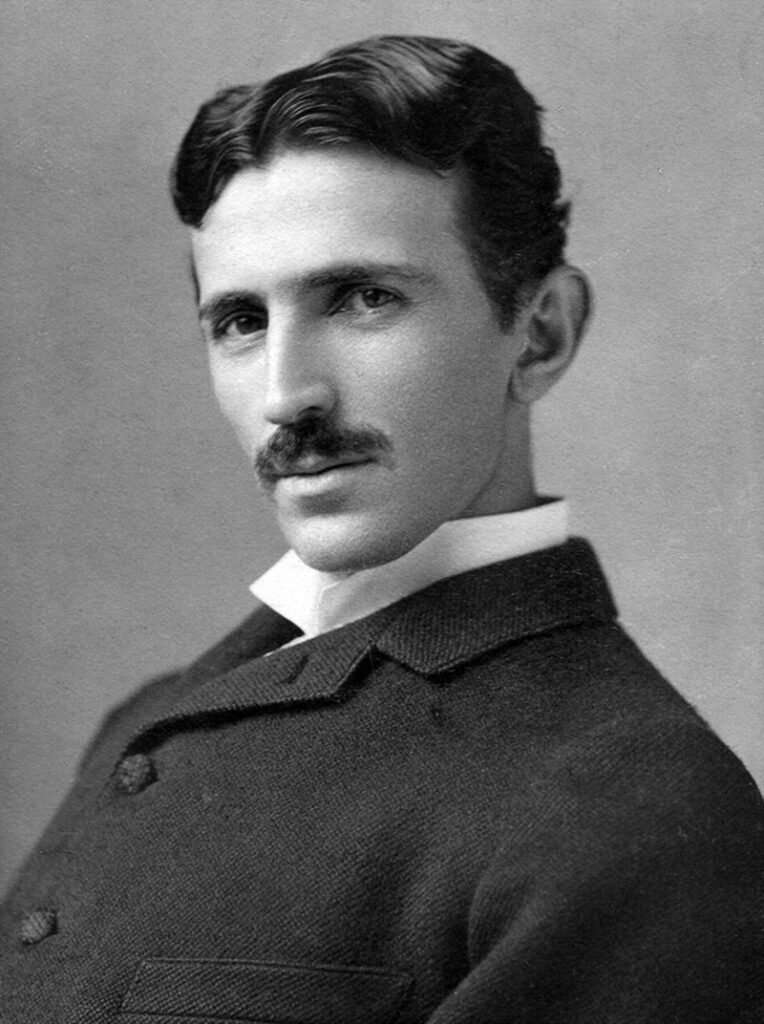
Introduction to Nikola Tesla
Early Life of Tesla
Born on July 10, 1856, in Smiljan, Croatia, to a Serbian Orthodox priest and his wife, young Nikola Tesla showed an early aptitude for invention and physics. Fascinated by the wonders of nature, Tesla was often inspired to replicate or improve upon natural phenomena.
This fascination fueled his lifelong love of innovation and learning, with his mother’s inventive skills and father’s academic background contributing to his early interests. At the age of 19, Tesla was admitted to the Austrian Polytechnic in Graz, Austria, on a Military Frontier scholarship, marking the commencement of his formal path into the world of sciences and engineering.
Tesla’s Career and Scientific Contributions
Tesla’s Time at the Continental Edison Company
In the early years of his career, Nikola Tesla played an instrumental role in the Continental Edison Company. Joining the Paris division in 1882, Tesla exhibited exceptional prowess in electrical engineering, rapidly ascending through the ranks due to his expertise in creating improved versions of dynamos. His notable work turned heads, earning him a golden opportunity to conduct experiments and designs on their behalf. His time here marked a crucial phase in his career and contributed to his future endeavors. Tesla’s role at the Continental Edison Company undeniably honed his skills, which he later implemented in his own inventions and theories.
Ac and the ‘War of Currents’
During the late 1880s, Tesla’s invention of a motor that could run on alternating current (AC) sparked a major technological standoff known as the ‘War of Currents’. While Thomas Edison supported the use of direct current (DC), Tesla collaborated with George Westinghouse, who bought his patents and backed the AC system.
The dispute arose from the fact that AC was more efficient for transmission over long distances as opposed to DC. Tesla’s AC system eventually emerged victorious when it was used to power the Chicago World Fair in 1893, signifying a pivotal win for Tesla in this battle. This success helped solidify the adoption of AC worldwide and cemented Tesla’s reputation as a pivotal figure in electrical engineering. Today, Tesla’s AC system is the universal method for transmitting power worldwide, underpinning his role in transforming the way we generate, transmit, and use electrical power.
Tesla’s Work on Wireless Technology and the Tesla Coil
Known predominantly for his significant contributions to the growth of electricity supply systems, Nikola Tesla also made revolutionary strides in wireless technology. One of his pioneering inventions is the Tesla Coil. Invented in 1891, this high-voltage, air-core, multiple-resonator transformer was used to produce high-frequency alternating currents. It generated extraordinarily high voltages, which could be utilized to transmit energy across large distances without wires.
This invention laid the strong foundation for the development of future wireless technologies and is still used today in radio technology. Furthermore, Tesla conceived the idea of a global wireless communication system in the early 1900s. Through this, he aimed to provide free electricity around the world and ensure instant communication, including the universal broadcasting of signals and messages. Unfortunately, his visionary project, Wardenclyffe Tower, designed to facilitate this, couldn’t see completion due to financial constraints. Nonetheless, Tesla’s ground-breaking ideas have played a pivotal role in shaping the technological landscape of the modern world.
Tesla’s Later Years and Experimental Projects
In the later stages of his life, Tesla ventured into a range of experimental projects, each reflecting his limitless curiosity and ingenuity. Notably, in the early 1900s, he began working on what he called the ‘World Wireless System’. His vision was to create a way to supply the world with free energy via a large electrical tower. Despite his tireless effort and dedication, this project, unfortunately, remained incomplete due to dwindling funds. Similarly, his alleged ‘Death Ray’, an anti-war machine said to end all wars with its massive destructive power, never saw completion. Despite this, his audacious endeavours remain unforgettable.
Tesla’s Patents and Technological Innovations
Tesla’s Unique Patents
The genius of Tesla is indisputable and is highlighted by his numerous unique patents. With over 300 registered to his name, his innovative and forward-thinking approach to engineering and physics is evident. Costly experiments, such as the development of the AC electrical supply system, resulted in patents on transformers, generators, and transmission lines, significantly impacting society and still being used today.
His pursuit of the idea of producing wireless electricity led to unique patents like the Tesla Coil, laying the foundation for future wireless technology advancements. Furthermore, his concept of a Tesla turbine and radio-controlled devices showcases his vision for the future. Each one of his patents represents a piece of his puzzle in creating a more technologically advanced world.
Overview of Tesla’s Technological Innovations
Known for his innovative and far-reaching inventions, Nikola Tesla played a significant role in shaping the technological landscape of the 20th century. His most notable contribution was the development of alternating current (AC) electrical systems, which set the standard for modern electricity supply. This marked a significant break from Thomas Edison’s direct current (DC) systems, which proved more efficient for long-distance transmission. Tesla also invented the Tesla Coil, an electrical resonant transformer circuit utilized in various fields such as radio, television sets, and even scientific research.
His conceptualization of wireless communication also preceded the advent of smartphones and Wi-Fi. Moreover, his work on remote control, electric power, electromagnetic fields, and radar proved to be a foundation for several modern-day technologies. These accomplishments demonstrate Tesla’s incredible foresight, as his theories and inventions continue to influence today’s wireless systems, electric vehicles, and many other technological components of our daily lives. His 300 patents stand as a testament to his revolutionary thinking and innovative approach, underscoring his status as a trailblazer in technological development.
Tesla’s Legacy and Influence on Modern Technology
Tesla’s Impact on the Field of Electricity and Engineering
Nikola Tesla’s contribution to electricity and engineering has left an indelible mark on the technological landscape. His invention of the alternating current (AC) electrical system is the basis for most electrical power used today, from powering homes to charging electric cars. This transformative invention supplanted Edison’s inefficient direct-current (DC) electrical system, forever changing the way electricity is distributed and consumed. In addition, Tesla’s numerous patents and inventions in areas such as radio waves, magnetic fields, and generator machinery form the backbone of many modern-day technologies. As such, his pioneering work underpins much of the conveniences we enjoy in the 21st century.
References to Tesla in Popular Culture
While Tesla’s remarkable contributions to science and technology laid the foundation for many modern advancements, his impact is not restricted to research labs or tech companies. The world of popular culture has not hesitated to celebrate and channel his genius. Almost a century after his demise, Tesla’s life continues to inspire books, films, music, and even video games. In film, he has been depicted in critically acclaimed productions such as “The Prestige,” where David Bowie played Tesla.
The Tesla coil has made appearances in video games, such as “Command & Conquer: Red Alert,” being used as a futuristic weapon. Musically, a heavy metal band in the U.S. adopted his name, highlighting his cultural resonance. Tesla has even inspired modern entrepreneurs, the most notable being Elon Musk, who named his electric car company, Tesla, Inc., as a homage to the great inventor. Through these references, Tesla’s legacy remains vibrantly alive within the heartbeat of popular culture.
Conclusion on the Life and Work of Nikola Tesla
Recap and significance of Tesla’s work
Nikola Tesla’s influential work has transformed the course of human history, predominantly within electrical engineering and electromagnetism. His pioneering endeavors, including the development of the AC electrical system, are foundational to modern power generation and supply, while his ideas in areas like wireless transmission predated much of today’s wireless technology.
Tesla’s numerous patents and theoretical work also provided a robust base for further enhancements in various scientific fields. Undoubtedly, Tesla remains an emblem of unbridled creativity and perseverance, and his contributions to science and engineering continue to resonate in our technologically advanced societies, cementing his importance in global history.
Lasting Impressions and Reflections on Tesla’s Life
In his final years, Nikola Tesla may have been overlooked by society, yet his innovative spirit lives on. Despite facing financial struggles, being undervalued, and often misunderstood, his pioneering contributions to electricity and magnetic fields continue to have an overwhelming influence. Even today, his theories form the basis for many modern technological inventions.
Tesla’s resilience, persistent curiosity in exploration, and unwavering dedication to science underscore the extraordinary life he led. A visionary, unconventional, and ahead of his time, Tesla exhibited that science was more than a profession—it was a calling, a drive to innovatively change the world we live in.



